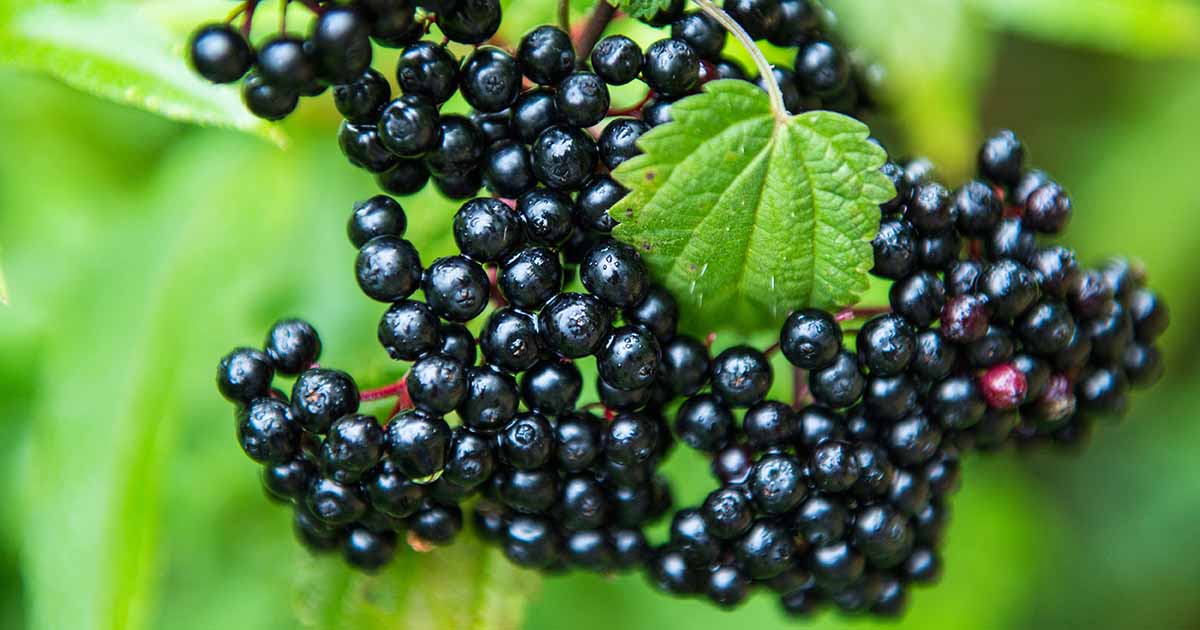Fertilizing
I strongly recommend you test your soil before feeding your plants.
Then, amend according to the results. If your soil doesn’t show any major deficiencies, you can use a balanced fertilizer.


Feeding should start in the early spring and should be repeated at even intervals three or four more times, ending in early fall.
Learn about how to fertilize elderberries here.
Species and Cultivars to Select
If you primarily want the fruits, most gardeners agree that blue elderberries are far superior to American in flavor.
European types tend to be the best looking if you want a good ornamental option, and the flowers are the most fragrant.
We have a whole guide that covers some of the best elderberry varieties, including the classic ‘Adams,’ ‘Black Lace,’ ‘Lemony Lace,’ and ‘York.’
I’ll just add a few here that I think are also worth checking out:
Black Tower
Black Tower™, aka ‘Eiffel,’ has deep, dark burgundy foliage that appears almost black.
The leaves have finely serrated edges, offering texture and interest. Medium pink buds open to light pink flowers followed by blackish-red berries.


Black Tower
This cultivar grows to about eight feet tall and four feet wide, with a narrow, upright shape. It grows well in Zones 4 to 8.
You can find Black Tower™ in #3 containers available at Nature Hills Nursery.
Cut Leaf
Cut leaf elderberry (S. nigra f. laciniata) is glorious, covered in fern-like leaves.
The shrub can reach up to 15 feet tall and is absolutely cloaked in heaps of beautiful white flowers followed by black fruit.


This form was discovered in Germany hundreds of years ago and has gained quite the reputation as an ornamental for growing in Zones 5 to 9.
It was awarded the Royal Horticultural Society’s Award of Garden Merit in 1993.
Red
Red elderberries (S. racemosa) do, in fact, have red fruits, though they can darken to a deep purple.
Native to Europe, Asia, and North America, this species thrives in moist areas of forests, such as along streambeds.


The berries are sometimes described as toxic, even when cooked, but native people in the Pacific Northwest have long consumed them and continue to do so today.
But the fruits absolutely must be cooked, no exceptions.
The species grows in Zones 3 to 9, but check the particular cultivar to make sure it will grow in your area.
Pruning and Maintenance
I know it’s painful to do, but prune off any flowers that appear in the first year after planting. You want to encourage the plant to develop a healthy root system.


You should always prune out any dead, diseased, or deformed branches. Otherwise, you don’t need to do any pruning until the third year.
Then, in early spring, head out with some pruners and go to town. Elderberry plants can handle a heavy prune to encourage dense growth and fruiting.
Learn more about elderberry pruning here.
Propagation
There are a few ways to propagate elderberries, you can start from seed, take cuttings or divisions, or you can purchase a potted or bare root plant from the nursery.
From Seed
Inside each berry is a single seed. Note that plants grown from seed may not grow true to the parent, so bear that in mind before you start!
Wait until the berries are ripe, and squash them gently to extract the seeds.

